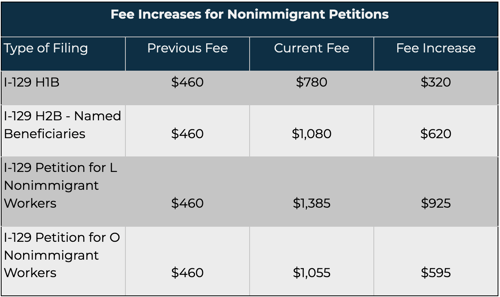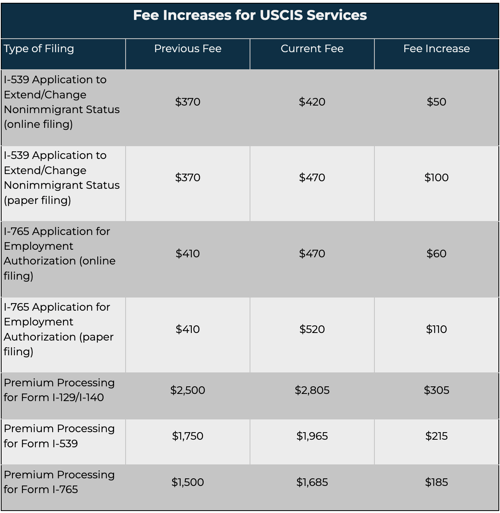Share this
What to Know About the Recent USCIS Fee Increases
by Phil on May 17, 2024 2:37:54 PM
In January 2024, the U.S. Department of Homeland Security (DHS) issued a final rule to implement its first major fee adjustment since 2016, citing operational and financial challenges within the U.S. Citizenship and Immigration Services (USCIS).
As of April 1, 2024, visa applications are now subject to the new, higher costs. This final rule marks a significant change to the financial burden for certain visa applicants and their sponsors. The fee increase notably impacts employment-based visa applications and key USCIS services like premium processing.
What Prompted USCIS Fee Adjustments?
Per the USCIS, the previous fee schedule did not adequately cover the operational costs needed to adjudicate immigration and naturalization benefits efficiently, leading to increased backlogs. To manage operational expenses and prevent future backlogs, the USCIS felt a pressing need to implement higher fees.
The USCIS relies primarily on filing fees to operate, with limited congressional funding, making it somewhat unique among U.S. governmental agencies. Despite significant efforts in recent years to tackle backlogs, the USCIS seeks to further develop and implement tools to increase efficiency and prevent future backlogs.
Specifically, current backlogs were worsened by a substantial drop in revenue during the COVID-19 pandemic, combined with a hiring freeze. Now, the USCIS is actively recruiting to address these backlogs. According to the agency, the introduction of a new fee schedule aims to secure the necessary resources to improve service efficiency and maintain financial stability.
However, the fee increases have been met with some resistance. In March 2024, the American Investor Alliance and IT Service Alliance filed a lawsuit in a Colorado federal court against the new USCIS fee rule, claiming it was enacted without proper public input or adequate notice.
Key Changes in USCIS Fees
The USCIS fee adjustments affect a broad range of visa and immigration processes. These changes involve increased costs across nonimmigrant petitions, immigrant petitions, and numerous other services.
Nonimmigrant Petition Fee Adjustments
The USCIS has announced significant fee increases for several nonimmigrant petitions. For larger employers–more than 25 full-time employees–H1B fees have jumped to $780, a substantial rise from the previous $460.

Similarly, the fee for H2B petitions with named beneficiaries increased to $1,080. The L1 visa saw an increase to $1,385, and O petitions rose to $1,055. Other categories–including E, H3, and TN–now cost $1,015. Smaller businesses and nonprofits have seen lesser increases or no change in some cases.
Immigrant Petition Fee Adjustments
For those seeking permanent residency in the United States, the USCIS is increasing filing fees across a range of immigrant forms. Form I-140 now costs $715 to file, a modest $15 increase from the previous fee. The application fee for Form I-485, to adjust residency status, has increased to $1,440, now integrating the biometrics fee.
Fee Updates for Additional Services
The USCIS also announced a fee increase for Form I-539, which is used by nonimmigrants seeking to extend or change their status in the United States, such as shifting from H1B to F1 to pursue academic studies. The new fees are $420 for online submissions and $470 for paper submissions, up from the previous fee of $370. This form applies to various visa categories covering students, tourists, and temporary workers, among others.
Similarly, the filing fee for Form I-765, which allows nonimmigrants to apply for work authorization has also increased. The fee is now $470 for electronic submissions and $520 for paper-based applications, a rise from the former $410.

The USCIS has also made notable changes to premium processing, shifting the adjudication period from calendar days to business days and significantly increasing fees for the service. As of February 26, 2024, the premium processing fee for Form I-129 and Form I-140 are now $2,805. For certain applications, the premium processing fees for Form I-539 and Form I-765 have risen to $1,965 and $1,685, respectively, marking substantial changes for those requiring expedited processing services.
Managing New USCIS Fees
With these significant application fee increases, smaller employers and startups, in particular, might refrain from sponsoring visas such as H1B, leading to decreased opportunities for skilled foreign workers in sectors like technology and engineering.
If you find your H1B opportunities limited, you might consider enrolling in a Day 1 CPT program. This approach allows you to work in your field of study from the first day of your academic program, thereby maintaining your employment in the United States while pursuing further education.
Conclusion
With changes to USCIS fees and forms now in effect, ensuring your application is accurate is as important as ever. Make sure you double-check that you are using the correct forms and submitting the correct fees as you prepare your submissions.
If you find that the updated USCIS procedures and fee structures are overwhelming, you don’t have to face them alone. Contact our team today for personalized assistance and expert advice to maximize your chances of success.